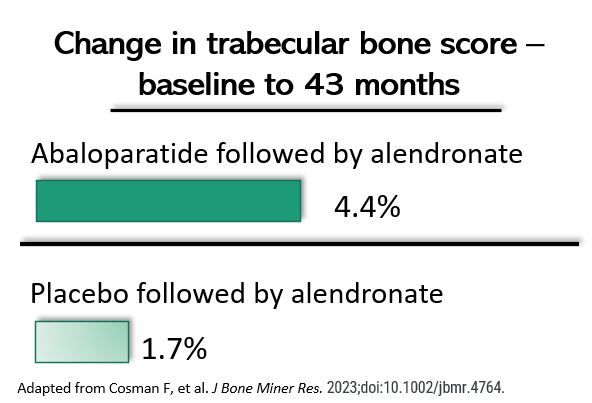- Clinical Technology
- Adult Immunization
- Hepatology
- Pediatric Immunization
- Screening
- Psychiatry
- Allergy
- Women's Health
- Cardiology
- Pediatrics
- Dermatology
- Endocrinology
- Pain Management
- Gastroenterology
- Infectious Disease
- Obesity Medicine
- Rheumatology
- Nephrology
- Neurology
- Pulmonology
Abolaparatide Increases Bone Microarchitecture and Strength in Women with Osteoporosis
In women with osteoporosis, treatment with abaloparatide for 18 months followed by treatment with alendronate for 24 months resulted in significantly greater improvement in trabecular bone score than initial treatment with placebo, according to new data published in the Journal of Bone and Mineral Research.
A parathyroid hormone-related protein analog, abaloparatide (Tymlos, Radius Health) improves bone mineral density (BMD) and importantly also improves microarchitecture of bone tissue, which when assessed by trabecular bone score (TBS), predicts fracture risk independent of BMD, according to study authors. Both bone mass and quality are used to determine fracture risk and improvements in both are relate to optimal reduction of the risk.
Led by Felicia Cosman, MD, professor of medicine in the division of endocrinology at Columbia University College of Physicians and Surgeons, investigators from the US and Sweden conducted a post-hoc analysis of 911 women who had been randomized to receive once-daily abaloparatide 80 mcg (457) or placebo (454) for 18 months in the Abaloparatide Comparator Trial In Vertebral Endpoints (ACTIVE) trial; both groups then received 70 mg alendronate once weekly for 24 months in the ACTIVExtend trial. DXA scans were performed at baseline, 6, 18, and 43 months to calculate TBS and using an algorithm to adjust for abdominal tissue thickness (TBSth).
Degraded bone microarchitecture was defined as TBSth <1.027, and a score between 1.027 and 1.074 as moderately degraded microarchitecture.

At baseline, 40% of women in the abaloparatide group and 43% receiving placebo had degraded TBSth. Among abaloparatide-treated participants during ACTIVE, TBSth increased by 2.4% at 6 months and by 4% at 18 months (P<.001) while no change was observed in those receiving placebo.
After the 24-month ACTIVExtend trial, total cumulative TBSth increased by 4.4% in the abaloparatide/alendronate group and by 1.7% in the placebo/ alendronate group. (group difference, P<.001)
The proportion of women with degraded TBSth in the abaloparatide/ alendronate group decreased from 40% at baseline to 24% at 18 months, with no corresponding change seen in the placebo/alendronate group. At 43 months, the proportion of women with degraded TBSth had decreased to 21% of the abaloparatide group and 37% of the placebo group (P<.05).
The authors say the increase in TBSth seen in this study is similar to that seen with another drug sequence, romosozumab-aqqg (Evenity, Amgen) followed by alendronate.
At 43 months, the research team observed vertebral fracture in 0.9% of the abaloparatide group and 5.1% of the placebo group. Investigators note that most of the fractures were seen in participants whose change in TBSth was less than the least significant change—the extent of change required for clinical significance.
“Abaloparatide increased TBSth rapidly and progressively over 18 months and increments were maintained over 2 years with alendronate. TBSth increase was associated with vertebral fracture risk reduction, the investigators wrote. They concluded that “Microarchitectural improvement may be one mechanism by which abaloparatide strengthens vertebral bone.”
Reference: Cosman F, Hans D, Shevroja E, Wang Y, Mitlak B. Effect of abaloparatide on bone microarchitecture assessed by trabecular bone score in women with osteoporosis: post hoc analysis of ACTIVE and ACTIVExtend. J Bone Miner Res. Published online January 1, 2023. doi:10.1002/jbmr.4764
